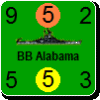warspite1ORIGINAL: rkr1958
So I went back to my notes and reconstructed my thinking for the scrapping of the Anson and the two land based swordfish. The Anson with a range of 5 had no air-to-sea factors and only 1 tactical and 2 strategic factors. Not sure how historical but seemed a perfect choice to scrap. Though, I have to admit from its picture it's a gorgeous aircraft.ORIGINAL: warspite1
warpite1ORIGINAL: rkr1958
No, my apologies ... I scrapped them because I didn't know better. I just added that to my list of what not to do next. If you don't mind, for historical flavor can you provide me insight about the roles and accomplishments of these aircraft during the war.
The Anson is an aircraft that I suspect is always scrapped in WIF - and with little wonder. But the sad fact is in 1939 this aircraft formed the backbone of Coastal Command (10 squadrons). Some of the problems were:
- not suitable for combat (1 fixed forward .303 machine gun (and one in a rear turret)
- a bomb load of just 4 x 100 pounders (not sure what they were supposed to do to a submarine....)
- here's the real doozy when one considers the purpose of Coastal Command - the Anson had insufficient range to patrol all the way to the Norwegian coast.....
So to be more realistic I think the Commonwealth should have to waste a pilot on this.
This aircraft says quite a lot about British preparedness for war in 1939. [Suggestion: I think the RAF should also be ensure that it has a Fairey Battle counter in the game if at all possible come May 1940].
As for the Swordfish... well this biplane was the backbone of the small Fleet Air Arm in 1939. Unlike the Anson (which was relegated to a training role where it enjoyed a long career (but not needed in WIF)) this antiquated aircraft did at least prove its combat worth - Taranto and the killing of Bismarck being perhaps its finest hours. The losses during the 'Channel Dash' proved that it was hopelessly obsolete, although the losses when attacking Scharnhorst in Norway in 1940 kind of confirmed that anyway. In WIF the FAA will have this aircraft as a carrier plane but there should be probably be a land based one too. At least unlike the Anson, the WIF Swordfish are actually useful - low range but good ASW component and perfect for the 0-box.
For the two swordfish, one with an air-to-sea of 4 and the other with 3, it was the range of 4 and the age of the aircraft as the reasons why I scrapped them. I did keep the Vildebaest, which has an air-to-sea of only 1, but a range of 9, which translates into a reaction range of 5 (i.e., half of 9 round up). With a reaction range of 5 and based in Liverpool this means that a Vilebeast based in Liverpool could react to the 0-box in the Faeroes Gap, Bay of Biscay or North Sea. Though granted, a 4-range swordfish based in Belfast could also react to both the Faeroes Gap or Bay of Biscay with 4 instead of 1 air-to-sea factors. However, during the nav air phase, the 9 range Vildebeast, if based in Belfast, could flyout to the 3-box of either the Faeroes Gap or Bay of Biscay, whereas the swordfish could reach the 1-box. Even if based right on the coast the 4-range swordfish could never reach higher than the 2-box.
Apparently, while my thinking wasn't historical at some level, I hope my scrapping decisions are within the realm of historical belivability. If any consolation, the CV Furious is loaded with carrier based swordfish.
You've given reasons why a (M)WIF player would, quite rightly, always scrap the Anson. But those reasons have nothing to do with historical reality which I thought this was about. You've said the Anson is a rubbish aircraft (as I said apart from as a trainer) and couldn't do the job it was used for. Exactly - and there were 10 squadrons of these in Coastal Command! To scrap it gives the CW a pilot to use on something more useful - which is great if you want to give Fighter Command numbers it didn't have or Bomber Command a capability in 1939 it didn't have.
Given that the Swordfish are present on the carriers - and the FAA was very small in 1939 (one counter would be enough) I think that not having the land-based version is an acceptable call.
I can see why you have the joint naval operations rule - to stop the French taking all this hits - but is not really required in the Western Mediterranean. I see you are insisting on a Force H type task force from day 1 at Gibraltar. This is not needed - the French had responsibility for the Western Mediterranean. Force H was needed only after the fall of France.
Not sure why the Malta Garrison requirement would only apply while Italy is neutral. The Med War panned out as it did - and the RN suffered so many losses (as did the RAF) - because of the desire to keep Malta in the game (long after it became any use as a naval station). To be historical the CW need to ensure they garrison Malta at all times and make every effort to ensure it does not fall.
But I'll butt out now as I don't think I'm quite understanding the historical vs good (M)WIF tactics trade-off.
Good luck with this mighty (and interesting) project though - that's a lot of work and I love the graphical representation [&o].






